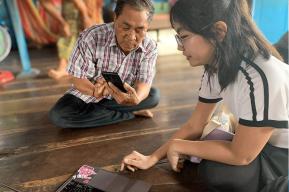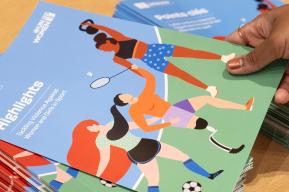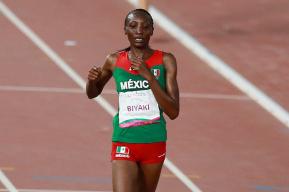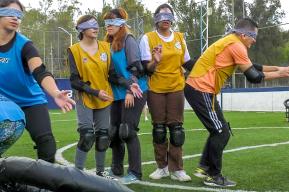0n 9 February 2024, UNESCO launched its Call to Action: Closing the Gender Gap in Science at an event celebrating the International Day of Women and Girls in Science. Despite some progress in recent years, gender equality in science remains elusive, particularly in certain disciplines and countries. Just one in three scientists worldwide is a woman. The Call to Action suggests avenues for closing this gender gap in science that range from designing interactive experiments for girls and boys from pre-school onwards to shattering the glass ceiling in the workplace.
The Call to Action has something for everyone – since the gender imbalance in science is a systemic problem. There are concrete recommendations for policy- and decision-makers at the level of governments, universities, research and educational institutions, funding organizations, philanthropic organizations and in the private sector.


The gender gap varies across scientific disciplines. Some fields, such as physics, tend to attract more men than women, whereas life sciences and health disciplines often showcase a more balanced gender distribution and, in some countries, a majority of women[1]. The gaps are greatest in engineering and computer science. Globally, women composed only 28% of engineering graduates and 40% of computer science graduates in 2018[2].
In high-income countries, the percentage of women in postgraduate physics positions has stalled at just below 20%, according to a 2019 article in Nature Reviews Physics[3]. In general, women continue to constitute a minority within domains pivotal to propelling the Fourth Industrial Revolution and shaping the future landscape of the job market, such as in artificial intelligence where women constitute a mere 22% of professionals.
Just 2% of venture capital goes to tech startups led by women. A survey undertaken between 2016 and 2022 by Startup Genome found that 31% of startups reported having at least one female founder but that, if you divided the number of female founders by the number of start-ups founders surveyed, women accounted for just 15% of the total. The Call to Action encourages partnerships with female-owned or female-led businesses in the science sector.
Why is there still a gender gap in science?
As UNESCO Programme Specialist Ana Persic stressed at the event, there is no single reason for the gender gap in science. Rather, it is the consequence of a combination of societal factors and systemic barriers. These include social, cultural and gender norms, the underrepresentation of women in leadership roles, unsupportive learning environments and inadequate working environments and work cultures.
The lack of visible role models is another factor. ‘Ask children to draw a scientist and most will draw a man’, she says. That is why UNESCO has partnered with the Fondation L’Oréal for the past 25 years to showcase the accomplishments of talented female researchers.
The Call to Action proposes dismantling gender stereotypes by making female role models more visible, opening educational pathways for girls in science and creating a workplace environment that attracts, retains and advances women.
Join UNESCO in Action to Close the Gender Gap in Science!
Share your actions with the UNESCO For Women in Science Team.
When panelist Sunshine De Caires from Trinidad and Tobago was asked by a Romanian student from one of the six secondary schools participating virtually in the event to name the biggest obstacle she had faced in her career, the PhD student evoked ‘the gender stereotypes because my field is largely male-dominated and I was one of the first women to enter my particular department as a woman in environmental science, particularly with a focus on soil science. Men would often treat me like I was fragile’, she said, ‘so they would try to shelter me, which is a positive thing but I had to also let them know that I was capable of doing it on my own’.

Make positive role models more visible
In order to make positive role models more visible, the Call to Action recommends, among other things, including more discoveries and stories from female scientists – with images – in school textbooks. It also advocates a greater presence of female scientists in the media (newspapers, magazines, radio, community radios, television and on internet) as well as in popular culture and the entertainment industry to showcase the variety of science-related careers available to girls and dispel gender-based misconceptions.
Open up scientific careers to girls
UNESCO is changing girls’ self-perception by encouraging science competitions which focus on girls. Justine Sass from UNESCO’s Education Sector observed that ‘often, even when girls outperform boys, their levels of self-confidence are lower. That’s why we have been supporting the Miss Science quiz in Malli since 2018, which has been picked up by the government’.
The Call to Action recommends this type of investment which rewards the excellent performance of girls in science and mathematics subjects through the provision of scholarships, awards and other incentives.
The Call to Action also recommends that science be introduced into the curriculum in pre-school and that teachers employ methods that engage both boys and girls in a playful and entertaining manner, to spark their curiosity and inculcate a culture of science from an early age. UNESCO has been working with teachers to help them adopt these methods. It is also important to support training for curriculum and textbook specialists, in order to remove gender bias and stereotype from teaching materials.
The Call to Action recommends engaging with parents and primary caregivers through school-based or advocacy initiatives to counter common misconceptions about science as well as gendered expectations that affect girls’ sense of self, behaviour and choices.

Justine Sass cited the example of UNESCO’s work in Brazil where ‘we have been working with a group called ‘Cinesolar’, which brings vans and cinemas into communities and far-flung communities. We invite both children and their parents to these screenings’.
The Call to Action recommends allocating resources to extracurricular science activities, including clubs, after-school activities and summer schools, to extend learning beyond the classroom and expose children to women working in scientific fields. Businesses can support this type of initiative.
Design gender-responsive institutional policies
At the policy level, the Call to Action recommends designing evidence-based gender-responsive institutional policies, including by instituting mandatory training sessions for managers, evaluation committees and recruitment officers. UNESCO also advocates applying the principle of equal pay for work of equal value and mandating transparency in decisions about pay and promotion. UNESCO also recommends prioritizing longer-term work contracts to support life choices and family planning.
For panelist Prof. Khaled Machaca, the Senior Associate Dean for Research, Innovation and Commercialization at Weill Cornell Medicine Qatar, it is vital for academic scientists to have a good work–life balance. ‘If you are going to produce at work, whether you are a man or a woman, you have to be comfortable at home’, he added, ‘from the technicians all the way up the faculty’. That is why ‘they all have the freedom to come and go as they please. Women with young children can take time off, work a few days at home and so on.’
He explained that, to get tenure at an academic institution, a scientist has to produce during the six years following their appointment as an assistant professor. This is ‘probably the most stressful time of your career because, if you don't produce during those six years, your career is over – the very career in which you have already invested ten years of your life to get to that stage. This doesn't work for women with young families, so we have invented programmes where the timeline is flexible’, he said. ‘Tenure doesn't have to come after six years and, in retrospect, these programmes have paid off’.
Combat gender-based violence
The Call to Action recommends implementing effective anti-harassment policies or strategies and clear guidelines for staff that cover both training to address sexism and sexual harassment (prevention) and strict punishments for perpetrators (responses), with a thorough impact assessment.
It is recommended that employers foster a culture of accountability and collaboration as opposed to supporting work environments that elevate individual team leaders to an ‘untouchable’ status which can lead to an abuse of power.
Promote women in leadership positions
The Call to Action encourages employers to support open-access soft skills training programmes for women, such as in leadership and negotiation, and to develop accessible databases and platforms that identify and provide contact information for female leaders in science to facilitate their involvement in panels, events and committees.
One challenge was brought up by Marielza Oliveira, the Director of the Division for Digital Inclusion and Policies and Digital Transformations at UNESCO. She mentioned that the frequent use of algorithms in the staff recruitment process could exacerbate gender bias in traditionally male-dominated fields, since these algorithms were often fed with the CVs of past candidates. ‘Since the individuals selected for high-tech posts have tended to be men in the past’, she said, ‘the recruitment algorithms have been trained on these male CVs, so tend to select male candidates’.
She also pointed out that, once you are aware of gender bias in algorithms, you can combat it. She mentioned how Sasha Luccioni, a machine learning specialist, had developed a tool that exposed biases in generative artificial intelligence datasets, making it possible to make those algorithms less biased.
The speakers agreed that artificial intelligence had its advantages, not least of which was its potential to enable women to support other women. ‘One of the great uses of algorithms is to find mentorship pairings for women who are developing their careers’, remarked Dr. Oliveira. This is the type of approach embraced by the Call to Action. It recommends fostering collaborative research among women, including through formal mentorship, sponsorship and networking programmes to allow women to share their experiences with others.
‘Digital ecosystems do offer some positives to women’, acknowledged Dr. Oliveira. For her, ‘digital ecosystems allow us flexibility that we didn't have before. Moreover, we can hide behind an avatar, so that nobody knows that you are actually a woman!’
Professor Jane Catherine Ngila, who won the L’Oréal–UNESCO For Women in Science International Award in 2021 and heads the African foundation for Women and Youth in Education, Science, Technology and Innovation in Kenya, picked up on the statistic cited in the UNESCO Science Report (2021) of just 12% of members of academies of science being women. ‘Having worked at the African Academy of Sciences’, she said, ‘I used to feel guilty every time I saw the numbers when we elected new fellows. At least now, the president of the Academy is a woman for the first time’.
‘I also sit on the World Academy of Sciences’ Advisory Committee for Chemical Sciences’, she said. ‘One of the most important criterion for the World Academy of Sciences for the advancement of science in developing countries is gender balance so, when you elect a new member, you must make sure that women make up not less than 30%’.

There are signs of improvement. Whereas just over 28% of scientists were women in 2013, that ratio is around one third today. However, monitoring progress towards numerical gender equality in science is being hampered by the fact that not all countries have reliable data. In the dataset gathered by the UNESCO Institute of Statistics, 98 countries – half of all countries – have not supplied any data at all on the number of women in science for the period from 2018 to 2021.
Since you cannot monitor what you cannot measure, the Call to Action recommends that countries invest in the collection of sex-disaggregated data on a regular basis to inform evidence-based policies and monitor progress in closing the gender gap. It recommends that such data indicate female representation and inclusion among researchers and trainees across disciplines, educational levels and career levels and that employers collect and report sex-disaggregated data at each management level.
Join UNESCO in Action to Close the Gender Gap in Science!
Share your actions with the UNESCO For Women in Science Team.

Watch the launch and rountable
Watch the recordings of the event “Closing the Gender Gap in Science: Accelerating Action”:
- Launch of the UNESCO Call to Action
- Roundtable #1: Fostering Girls’ Interest in Science through Innovative Education in the Digital Age
- Roundtable #2: Promoting Empowering Work Environments for Women in Science
- Roundtable #3: Inspiring Women and Girls in Science through Role Models and Mentors
Contact
[1] Pew Research Center. (2021, April). STEM Jobs See Uneven Progress in Increasing Gender, Racial, and Ethnic Diversity. Washington, D.C.
[2] UNESCO. (2021). To Be Smart, the Digital Revolution Will Need to Be Inclusive: Chapter 3 in UNESCO Science Report. Paris.
[3] Skibba, R. (2019). Women in Physics. Nature Reviews Physics, 1, 298–300.










